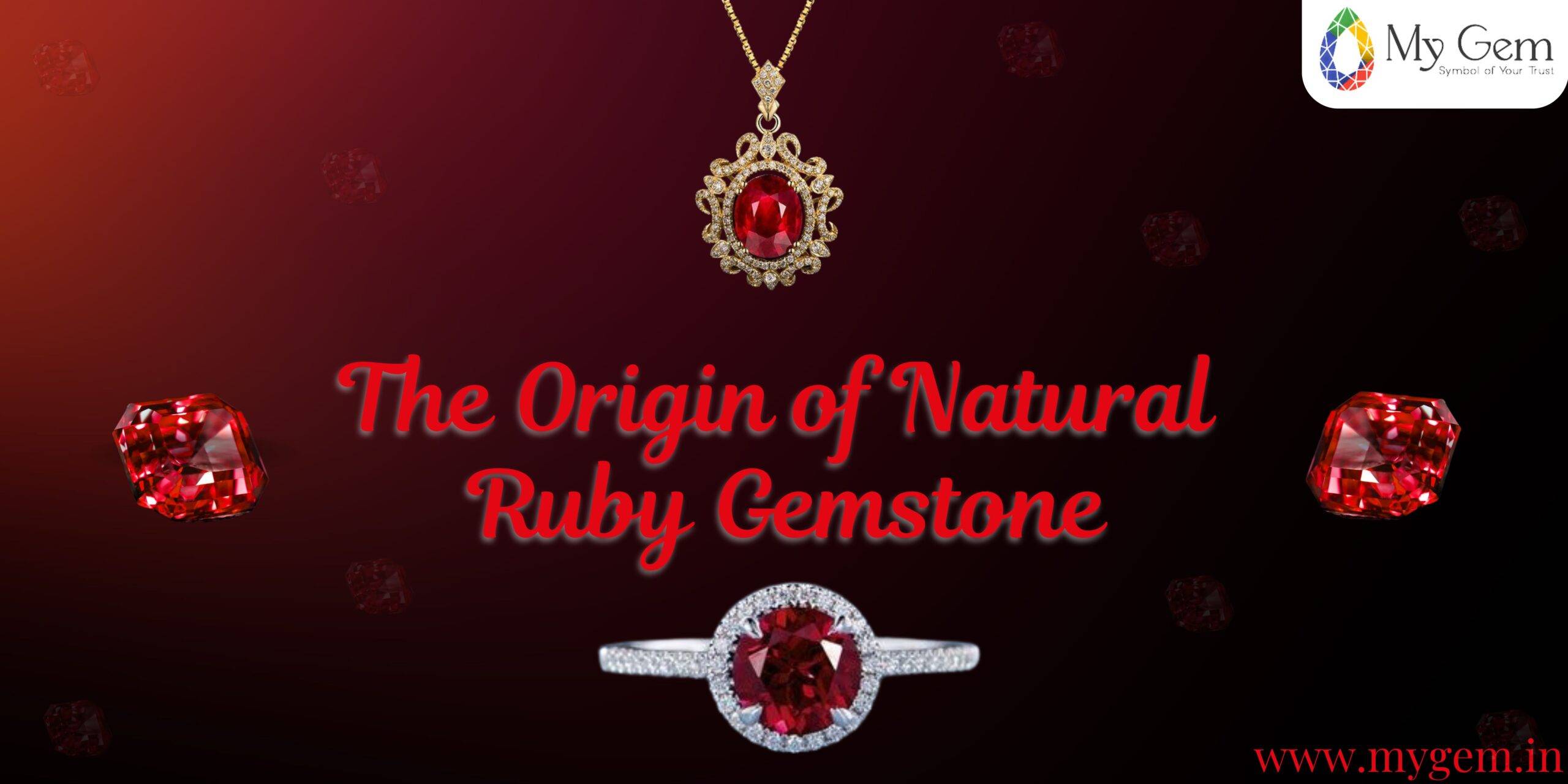Rubies are among the most cherished gemstones in the world, known for their deep red hue and mesmerizing beauty. The origin of a natural ruby gemstones plays a significant role in determining its quality, value, and desirability. In this blog, we’ll explore where these beautiful gems come from and what makes them so special.We’ll also look at how to identify an original ruby gemstone and why the origin matters when purchasing one.
What is a Ruby Gemstone?
A ruby gemstone is a precious stone that belongs to the corundum family, which also includes sapphires. Its striking red color comes from the presence of chromium. Rubies are classified as one of the “big four” gemstones, alongside diamonds, emeralds, and sapphires.
While there are synthetic versions available, a natural ruby gemstone is formed over millions of years deep within the Earth. Rubies are not just beautiful; they are also durable, making them a popular choice for jewelry, especially in rings and necklaces.
The Origin of Natural Ruby Gemstones

Geological Formation of Ruby Gemstones
Rubies are formed in metamorphic rocks due to intense heat and pressure beneath the Earth’s surface. The red color of the natural ruby gemstone is caused by the presence of chromium in its chemical structure. It takes millions of years for these gemstones to form and become the stunning rubies we see today.
Key Ruby Mining Locations
The origin of a ruby is significant because it affects the gem’s quality and value. Some of the top locations where natural ruby gemstones are found include:
- Myanmar (Burma): Rubies from Myanmar, particularly from the Mogok Valley, are considered some of the finest in the world. Burmese rubies are famous for their “pigeon blood” red color, which is highly sought after. These rubies are considered to be the best ruby gemstones due to their vivid color and exceptional quality.
- Sri Lanka: Known as the “Island of Gems,” Sri Lanka produces lighter-colored rubies. Although these rubies may not be as deep red as Burmese rubies, they are still appreciated for their clarity and brilliance.
- Madagascar: This country has recently become a significant source of ruby gemstones. Rubies from Madagascar vary in color, ranging from deep red to pinkish tones.
Historical Significance of Ruby Gemstones
Rubies have been treasured for thousands of years. In ancient times, they were considered symbols of power and protection. In India, rubies, also known as manek or manek ratna, were believed to bring success and good fortune to the wearer.
Identifying an Original Ruby Gemstone
With so many synthetic and treated rubies on the market, it can be challenging to identify an original ruby gemstone. Here are a few tips:
- Natural vs. Synthetic Rubies: A natural ruby gemstone is formed naturally, while synthetic rubies are made in laboratories. Natural rubies have inclusions, or tiny imperfections, which prove they are genuine. Synthetic rubies are often flawless, making them easier to spot.
- Certificate of Authenticity: When purchasing a ruby, always ask for a certificate of authenticity. This certificate should confirm that the ruby is natural and specify its origin. The origin is critical because rubies from certain regions, such as Myanmar, are more valuable than those from other areas.
- Visual Characteristics: Natural rubies may have slight color variations and inclusions that give each stone a unique look. A completely flawless ruby is likely to be synthetic or heavily treated.
The Value of Ruby Gemstones Based on Origin
The ruby gemstone origin plays a crucial role in determining its value. Rubies from Myanmar (Burma) are often the most expensive due to their rich color and historical significance. On the other hand, rubies from Madagascar and Sri Lanka may be more affordable, but they are still valuable, depending on their quality.
When buying a ruby, it’s essential to consider not just its appearance but also where it comes from. A Burmese ruby, for example, will be far more valuable than a ruby from a less famous region.
The Role of Rubies in Jewelry and Astrology
Rubies are a favorite choice in fine jewelry, particularly for engagement rings and statement necklaces. The deep red hue of ruby gemstones symbolizes love and passion, making them ideal for romantic gifts.
In astrology, rubies, or manek ratna, are considered powerful stones. In Vedic astrology, wearing a natural ruby gemstone is believed to bring strength, energy, and confidence to the wearer. Many believe that rubies can help align the body and mind, promoting overall well-being.
Famous Ruby Gemstones in History
Several famous rubies have made history due to their size, color, and origin. For instance, the Sunrise Ruby, weighing over 25 carats, is one of the most expensive rubies ever sold. Its Burmese origin and rare “pigeon blood” color make it a valuable and highly sought-after gemstone. Another well-known ruby is the Edwardes Ruby, which is part of the British Crown Jewels.
Ethical Sourcing of Ruby Gemstones
When buying a natural ruby gemstone, it’s essential to consider whether the stone has been ethically sourced. Ethical sourcing ensures that the gemstone was mined responsibly, without harming the environment or exploiting local communities. Look for certifications that confirm the gemstone has been sourced ethically, ensuring you are purchasing a gem that benefits both the Earth and its people.
Tips for Buying an Authentic Natural Ruby Gemstone
If you’re considering purchasing a ruby, here are some key tips:
- Request Certification: Always ask for a certificate that confirms the ruby’s authenticity and origin. This will assure you that you’re getting a natural ruby gemstone and not a synthetic or treated stone.
- Check the Color and Clarity: A high-quality ruby gemstone will have a deep red color with good clarity. While inclusions are normal in natural rubies, avoid stones with too many visible imperfections.
- Work with Reputable Jewelers: Make sure to buy from a trusted jeweler who specializes in precious gemstones and can provide you with all the necessary information about your purchase.
Conclusion
The origin of natural ruby gemstones plays a vital role in determining their beauty, value, and uniqueness. Whether you’re looking for a natural ruby gemstone for jewelry or its astrological benefits, understanding its origin and authenticity is crucial. Always seek expert advice and ensure you’re buying an authentic original ruby gemstone to enjoy the true beauty and value of this precious gem.
FAQ
1. How can I tell if a ruby gemstone is natural?
Look for inclusions in the ruby and request a certificate of authenticity to confirm it’s a natural ruby gemstone.
2. What makes Burmese rubies more valuable than other ruby gemstones?
Burmese rubies are highly valued for their rich “pigeon blood” color and exceptional quality, making them rarer than others.
3. Why is the origin of a ruby gemstone important?
The origin of a ruby gemstone influences its value, color, and rarity, with Burmese rubies being the most sought after.
4. Are synthetic rubies less valuable than natural rubies?
Yes, synthetic rubies are typically less valuable than natural ruby gemstones due to their artificial creation.
5. What is the difference between a treated and an original ruby gemstone?
An original ruby gemstone is untreated and natural, while treated rubies have enhancements to improve color and clarity. Untreated rubies are generally more valuable.


Leave a comment